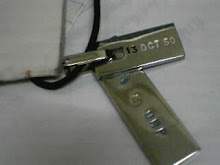
Image : http://www.flickr.com
There are several different methods for teeth whitening ranging from professional products only available if the work is carried out by your dentist to very basic tooth whitening products such as toothpastes.
Teeth whitening basically works by bleaching, or in the case of whitening toothpaste by removing stains from the surface of your teeth through abrasive means.
Most teeth whitening products contain either carbamide peroxide or hydrogen peroxide as a bleaching agent with the former being the main component of professional bleaching products.
Bleaching lightens the color of your teeth but the degree of lightening is dependant on the type of product you use. Laser teeth whitening is perceived by many to be the most effective method as the laser light activates the bleaching agent thus speeding up the teeth whitening process. However it is the most costly way of whitening your teeth and is a process that will need to be repeated at regular intervals (every one – three years depending on how well you look after your newly whitened teeth).
Tray based teeth whitening products also work by bleaching your teeth but have an added advantage over laser whitening in that the custom mouthpiece can be re-used when you want to whiten your teeth again. The only consumable is the teeth whitening bleaching agent. Tray based tooth whitening products can be purchased through your dentist or over the counter tray based products are now available that use the preferred carbamide peroxide as the bleaching agent.
Paint on teeth whitening products and whitening strips are available over the counter for not a lot of money but there appears to be little support for any over the counter products other than tray based teeth whitening with carbamide peroxide.
Bleaching works well for whitening yellow teeth but is not the answer in every situation so it is advisable to seek the advice of your dentist. Your dentist may recommend that you don’t use teeth whitening products if your teeth are sensitive, you have worn enamel, cavities, gum disease or in other situation where tooth whitening may prove detrimental to your health or the health of your teeth.
Teeth whitening through bleaching is not normally recommended for individuals that have crowns, bridges or other types of prosthetic teeth as bleaching will not lighten the colour of anything other than your natural teeth leaving anything else looking out of place. In such instances it may be worth looking at paint on teeth whitening products that can be used to whiten individual teeth.
If you are an unsuitable candidate for teeth whitening products then you may have other options open to you such as dental veneers or crowns.
Teeth whitening toothpaste, can be quite useful after teeth whitening to help maintain the lighter colour of your teeth with their abrasive action helping to remove new stains from the surface of your teeth.


0 Responses to "How Tooth Whitening Work"
Post a Comment